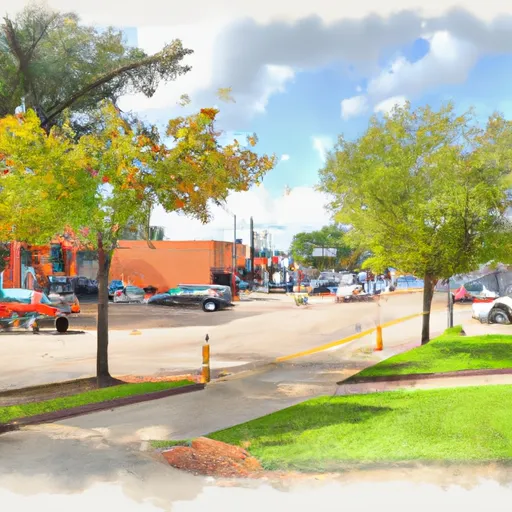-
 Snoflo Premium
Snoflo Premium
Get unlimited access to all our content
With no Ad interruptions! - Start Your Free Trial Login with existing account
Mill-Creek
Eden Index
Climate
9.7
•
Recreation
4.4
•
Community
1.5
•
Safeguard
5.8/10

Mill Creek, Oklahoma is a small town located in Johnston County in the southeastern part of the state. It experiences a humid subtropical climate, characterized by hot and humid summers and mild winters. The average temperature in summer ranges from 75°F to 95°F, while winter temperatures average between 30°F and 50°F. The area receives an annual precipitation of around 45 inches, with rainfall occurring evenly throughout the year.
The town is named after the nearby Mill Creek, a tributary of the Blue River. The hydrology constituents of Mill Creek consist of various small streams, creeks, and rivers that flow through the region, providing a picturesque landscape. These water bodies offer opportunities for fishing, kayaking, and other water-based activities.
Mill Creek is surrounded by natural beauty, making it an ideal destination for outdoor enthusiasts. The area is home to several parks, forests, and wildlife management areas, providing ample opportunities for hiking, camping, and birdwatching. Popular outdoor recreation spots include the Tishomingo National Wildlife Refuge, Blue River Public Fishing and Hunting Area, and McGee Creek State Park. Overall, Mill Creek offers a serene environment with diverse outdoor recreation opportunities for visitors to explore and enjoy.
What is the Eden Index?
The Snoflo Eden Index serves as a comprehensive rating system for regions, evaluating their desirability through a holistic assessment of climate health, outdoor recreation opportunities, and natural disaster risk, acknowledging the profound impact of these factors on livability and well-being.
Climate Health Indicator (CHI): 9.7
Mill-Creek receives approximately
1030mm of rain per year,
with humidity levels near 78%
and air temperatures averaging around
17°C.
Mill-Creek has a plant hardyness factor of
7, meaning
plants and agriculture in this region tend to thrive during the non-winter months.
By considering the ideal temperature range, reliable water supplies, clean air, and stable seasonal rain or snowpacks, the Climate Health Indicator (CHI) underscores the significance of a healthy climate as the foundation for quality living.
A healthy climate is paramount for ensuring a high quality of life and livability in a region, fostering both physical well-being and environmental harmony. This can be characterized by ideal temperatures, reliable access to water supplies, clean air, and consistent seasonal rain or snowpacks.
Weather Forecast
Streamflow Conditions
Washita
Area Rivers
Washita
Snowpack Depths
Washita
Reservoir Storage Capacity
Washita
Groundwater Levels
Recreational Opportunity Index (ROI): 4.4
The Recreational Opportunity Index (ROI) recognizes the value of outdoor recreational options, such as parks, hiking trails, camping sites, and fishing spots, while acknowledging that climate plays a pivotal role in ensuring the comfort and consistency of these experiences.
Access to outdoor recreational opportunities, encompassing activities such as parks, hiking, camping, and fishing, is crucial for overall well-being, and the climate plays a pivotal role in enabling and enhancing these experiences, ensuring that individuals can engage in nature-based activities comfortably and consistently.
Camping Areas
| Campground | Campsites | Reservations | Toilets | Showers | Elevation |
|---|---|---|---|---|---|
| Little Elm Park | None | 547 ft | |||
| Walnut Creek Resort | 25 | 650 ft | |||
| Juniper Point - Lake Texoma | None | 655 ft | |||
| Lighthouse Resort | None | 673 ft | |||
| Cedar Bayou Marina - Lake Texoma | None | 647 ft | |||
| Texoma Marina | None | 651 ft | |||
| Brier Creek - Lake Texoma | None | 656 ft | |||
| Erwin Park - McKinney | None | 637 ft | |||
| Isle du Bois - Roberts Lake State Park | 182 | 685 ft | |||
| Buncombe Creek - Lake Texoma | None | 659 ft |
Catastrophe Safeguard Index (CSI):
The Catastrophe Safeguard Index (CSI) recognizes that natural disaster risk, encompassing floods, fires, hurricanes, and tornadoes, can drastically affect safety and the overall appeal of an area.
The level of natural disaster risk in a region significantly affects safety and the overall livability, with climate change amplifying these risks by potentially increasing the frequency and intensity of events like floods, fires, hurricanes, and tornadoes, thereby posing substantial challenges to community resilience and well-being.
Community Resilience Indicator (CRI): 1.5
The Community Resilience Indicator (CRI) recognizes that education, healthcare, and socioeconomics are crucial to the well-being of a region. The CRI acknowledges the profound impact of these elements on residents' overall quality of life. By evaluating educational resources, healthcare accessibility, and economic inclusivity, the index captures the essential aspects that contribute to a thriving community, fostering resident satisfaction, equity, and social cohesion.

